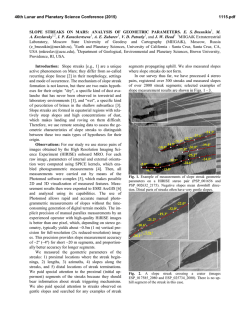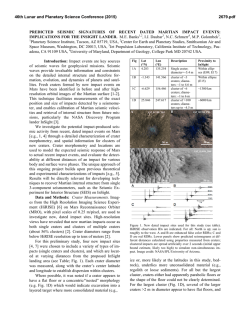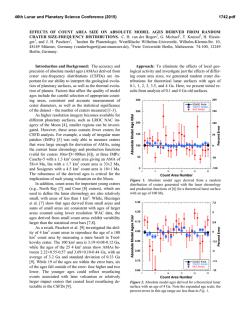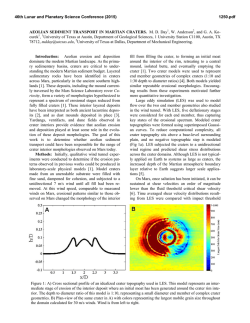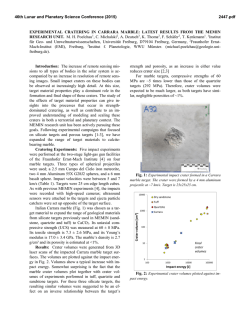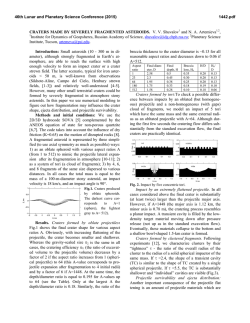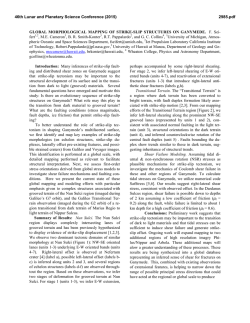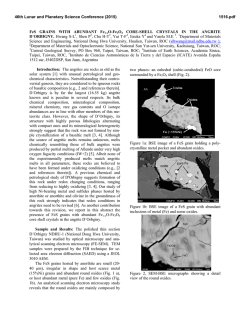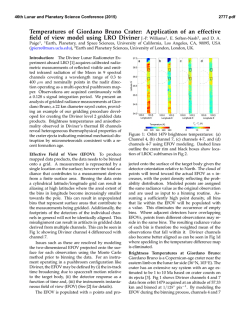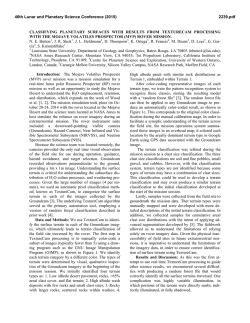
2273
46th Lunar and Planetary Science Conference (2015) 2273.pdf WIND STREAK-LIKE YARDANG TERRAIN IN DAEDALIA-MANGALA, MARS. H. Hargitai1, T. Látos1, D. Horváth, D. Bakos1 1Eötvös Loránd University, Planetary Science Research Group, 1117 Budapest, Pázmány P st 1/A [email protected] Introduction: Wind streaks are elongate albedo patterns generally appearing on the lee sides of topographic obstacles [1, 2] . Streak may form by the deposition, erosion or the lack of deposition of aeolian sediments, associated with topographic obstacles [3, 4]. They can appear, disappear or change appearance on timescales as short as a few weeks [5]. On Mars, aeolian wind streaks concentrate in several regions, including NW Daedalia Planum (Fig. 1), SW Syris Major Planum, the Cerberus Fossae region, S Amazonis Planitia. Reticular ridges are meter-scale, polygonally textured bedforms that mantle underlying topography proposed to be composed of aggregated airfall dust. Some are indurated and can be eroded into yardangs [6]. Here we describe features that appear as wind streaks on daytime THEMIS infrared images but are complex topographic features as revealed by higher resolution CTX images: intersecting yardang sets formed on one side of impact craters. A continuous yardang terrain may or may not be connected to the elongate wind tail-like yardang terrain. They are interpreted to be remnants of a more extended mantle of friable material. The most frequent type is where a lighter part is formed behind the crater, which has a width similar to the crater and a darker part that surrounds this. The darker part is generally gradually widens away from the crater (Fig. 2a). In some cases a second lighter part is added around the darker part (Fig 2b). Fig. 2a. Composite-albedo wind streak. Portion of CTX P06_003371_1699_XN_10S143W. Fig. 2b. Wind streak with two lighter part. Intracrater (crater-affiliated, [7]) wind streaks are also observed (Fig. 3). These form together with regular wind streaks or they may lack the wind streak at the lee of the crater. Fig. 1. The studied region. The thick line separates regions “1” (SE trending yardang tails) and “2” (NW trending wind streaks). Wind streaks: Wind streaks are generally either brighter or darker than their surroundings, however, there are many craters within this area with composite wind streaks displaying light and dark zones. There aren’t two similar wind streaks in the area, suggesting a complex, locality-dependent formation process. Fig. 3. Wind streak at the bottom of a crater. Yardang terrains: In the western edge of the volcanic Daedalia Planum, in the vicinity of Mangala Fossa, south from the Meduase Fossae deposits, two “inverse” regions can be distinguished (Fig. 1): 46th Lunar and Planetary Science Conference (2015) (A) SE trending elongate yardang terrains associated with craters surrounded by exhuming pre-yardang terrain (sets of indurated reticulate ridges that form wind tails behind impact craters). (Fig. 5-6) (B) NW trending eroding pre-yardang terrain in the center of regular wind streaks associated with craters, surrounded by a continuous yardang terrain (Fig. 7) Some wind streaks do not affect the underlying, either pre-yardang and yardang, terrain. Interpretation: Wind streaks generally form as the rim of craters protect are area in wind shadow from aeolian erosion. The actual shape of wind streaks may be influenced by the local relief. Wind streak sizes may depend on wind conditions and availability of material. Albedo of wind streaks may depend on the material properties, grain size, microtopography and possible layering (e.g., [7].) On Mars, the brighter material tends to be finer, weathered dust, and the darker material tends to be coarser grained [8]. By studying the direction of the wind streaks, we can draw conclusions about the prevailing wind of the area, however, the direction of the wind streaks can differ from year to year and some steaks are associated with specific dust storms that swept over the area in certain years [e.g., 9]. Whereas wind streaks may form on very short timescales, indurated reticulate ridges (or duststones) are supposedly eroded into yardangs on much longer timescales. On an erosional surface where craters are exhuming, regular (albedo) wind streaks probably indicate recent and short-term wind directions while an elongate patch of yardang terrain on one side of a crater is suggestive of the long-term work of a stable prevailing wind direction. There are several sets of yardangs with orientations different from that of the present wind tail-like feature, suggesting several, moderately different long-term paleowind directions. The elongate, wind tail-like yardang terrain appears to be a non-erosional surface, the remnant of a formerly continuous mantle of friable material. However, the formation of case (A) (Figs 5-6) and (B) (Fig. 7) appears to be different due to different deposit thicknesses, wind directions, wind speeds or other factors. References: [1] Sagan C, Veverka J, Fox P, Dubisch R, Lederberg J, Levinthal E, Quam L, Tucker R, Pollack JB, Smith BA (1972) Icarus, 17, 346-72. [2] Thomas PC, Veverka J, Lee S, Bloom A (1981) Icarus 45, 124–153. [3] Greeley R (1999) LPSC XXX, #1300. [4] Drake NB, Hargitai H (2014) doi: 10.1007/SpringerReference_368496 [5] Greeley R, Whelley PL, Neakrase LDV, Arvidson RE, Bridges NT et al (2008) J Geophys Res 113:e06s06. doi:10.1029/2007je002971 [6] Bridges NT, Banks ME, Beyer RA, Chuang FC et al. (2010) Icarus 205 (1), 165–182. [7] Rodriguez et al. (2010) Geomorphology v. 121, pp. 30-54.[8] 2273.pdf Reiss D, Raack J, Hiesinger H (2011) Icarus 211, 917-920. [9] Fisher J, Richardson M, Newman C, Szwast M, Graf C, Basu S, Ewald S, Toigo A. Wilson R (2005), J. Geophys. Res., 110, E03004, doi:10.1029/2003JE002165. Fig. 5. (marked A on Fig. 1) Unnamed crater near 17S, 214E. The remnant yardang terrain makes up the SE trending wind streak. Both yardang set orientations are different from the wind-tail-like feature’s orientation. Fig. 6. Remnant yardang terrain near 14S 217E. The orientation of yardangs is different from the orientation of the windtail-like feature. The yardang terrain – crater rim contact is considerably different from that shown in Fig. 2. Fig. 7. (B) Unnamed crater near 9S 217E. The surrounding yardang terrain is eroded at the NW trending wind streak.
© Copyright 2025
